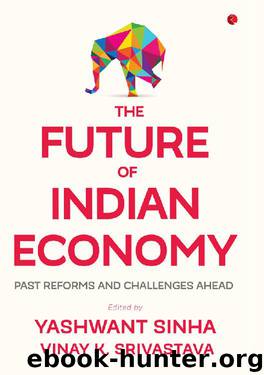The Future of Indian Economy: Past Reforms and Challenges Ahead by Yashwant Sinha & Vinay K. Srivastava

Author:Yashwant Sinha & Vinay K. Srivastava [Sinha, Yashwant]
Language: eng
Format: epub
Publisher: Rupa Publications
Published: 2017-07-06T18:30:00+00:00
In interpreting Article 292 of the Constitution, a view had been taken till then that it covered only the ‘Public Debt’ forming part of the Consolidated Fund of India as this alone can be deemed to be ‘borrowing upon the security of the Consolidated Fund of India’. The paper included arguments and suggested mechanisms to include the liabilities under the Public Account within the ambit of a law under Article 292.
The analysis of fiscal trends had brought out that if the external debt was to be revalued at current exchange rates, e.g. on the rates prevalent on 31 March 1999, the total central government liabilities were of the order of 60% of GDP with reference to new series of GDP. (That, of course, was the incomplete story on debt because the liabilities of the state governments were also to be considered for fair international comparison.)
To maintain current growth and even enhance it, enjoy the pleasures of modest inflation and stay away from an embarrassing BoP crisis, nurture the health of our banking system, the prevailing fiscal stance was not sustainable. On these lines, the study established the desirability and feasibility of a law under Article 292.
After careful survey of international practices and from our own cultural ethos, it was found that the ‘golden rule’ of borrowing—avoid borrowing for consumption purposes—would be helpful for India and readily find wider acceptance. The paper also suggested using constitutional provisions as powerful instruments to spur state level fiscal reforms, for limiting the debt and deficit in the states, which was necessary if the central government were to contain its debt and deficit.
While this paper was being deliberated on file, it emerged that the issues raised need wider consultations, especially from RBI and the Ministry of Law & Justice. The RBI was approached to give its inputs and it prepared a detailed analytical paper of its own. The finance ministry approved setting up a high-level committeei to study this issue and prepare a draft legislation. Besides the members of this committee on Fiscal Responsibility Legislation, several distinguished officers deliberated on the FRBM Act right from the ideation stage in June 1999 when I started work on the project, including Dr Shankar Acharya, Dr Arvind Virmani, Dr Vijay L. Kelkar, Dr Urjit Patel, C.M. Vasudev, P.G. Mankad, Dr Y.V. Reddy, to mention a few prominent ones.
One of the most memorable quips by an officer sceptical of the idea of FRBM Act was to compare the move to enact a law to cap government debt with a vow to remain celibate or virtuous. He implied that if the government wanted to control public debt, it was free to do so, with or without legislation, and if the government did not care about public debt, no law will be able to prevent it from indulgence in debt.
However, what helped carry my initiative forward had more to do with ready acceptance of fiscal discipline as good policy by the then Finance Minister Yashwant Sinha and the Prime Minister Atal Bihari Vajpayee than with any technical analysis we had carried out.
Download
This site does not store any files on its server. We only index and link to content provided by other sites. Please contact the content providers to delete copyright contents if any and email us, we'll remove relevant links or contents immediately.
International Integration of the Brazilian Economy by Elias C. Grivoyannis(90978)
The Radium Girls by Kate Moore(11921)
Turbulence by E. J. Noyes(7936)
Nudge - Improving Decisions about Health, Wealth, and Happiness by Thaler Sunstein(7615)
The Black Swan by Nassim Nicholas Taleb(7010)
Rich Dad Poor Dad by Robert T. Kiyosaki(6401)
Pioneering Portfolio Management by David F. Swensen(6226)
Man-made Catastrophes and Risk Information Concealment by Dmitry Chernov & Didier Sornette(5921)
Zero to One by Peter Thiel(5685)
Secrecy World by Jake Bernstein(4644)
Millionaire: The Philanderer, Gambler, and Duelist Who Invented Modern Finance by Janet Gleeson(4374)
The Age of Surveillance Capitalism by Shoshana Zuboff(4209)
Skin in the Game by Nassim Nicholas Taleb(4162)
Bullshit Jobs by David Graeber(4094)
The Money Culture by Michael Lewis(4076)
Skin in the Game: Hidden Asymmetries in Daily Life by Nassim Nicholas Taleb(3929)
The Dhandho Investor by Mohnish Pabrai(3699)
The Wisdom of Finance by Mihir Desai(3653)
Blockchain Basics by Daniel Drescher(3507)
